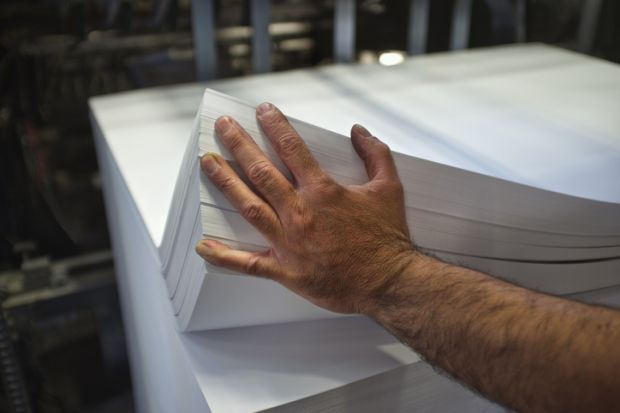When one of the largest independent book and journal printers in the US closed its doors last summer, many university presses braced themselves for printing delays. What they didn’t expect from the closure of Edwards Brothers Malloy was that the disruption would continue into 2019.
“It was really bad this fall,” said Gregory Britton, editorial director of the Johns Hopkins University Press. He said that the printing schedules of most of the press’s new titles were delayed.
Mr Britton initially believed that the delays were because of the paper shortages that have affected much of the publishing industry – including newspapers and magazines. But this was not the major cause of delays for university presses, he said.
“The companies that manufacture books are inundated with work,” said Britton. “There’s been a lot of consolidation and now there’s less capacity. In the past when there were delays, we might have been able to shift work to a different printer – now those printers don’t exist.”
As a result, book and journal publishers and university presses are scrambling to adjust to longer, sometimes unpredictable, printing schedules.
In addition to printers closing or merging, university presses have in recent years been printing books in smaller batches so that they don’t end up with unsold books.
“Instead of printing two years’ supply, presses might print a six-month supply to keep inventory costs down,” said Mr Britton.
More frequent reprinting has put additional pressure on printers, however. “They’re swamped,” he said.
University presses publish lots of academic monographs that don’t have strict deadlines, said Mr Britton. But they also publish commercial trade titles that need to be printed before key selling periods such as Christmas – and there are academic works that need to be out early in the year to be considered for autumn course adoption. Consequently, there is “always a big rush before the holidays to get books printed,” he added.
Representatives of several university presses contacted by Inside Higher Ed said that their companies – West Virginia University Press, George Mason University Press, the University of Iowa Press and Penn State University Press – had also experienced longer printing schedules than usual in recent months.
“We’ve had a few close calls,” said Jennifer Norton, associate director of Penn State University Press. “It’s important that books be printed in time for conferences, events and book signings, but some conference deadlines were missed last year,” she said.
Previously, Ms Norton would have allowed four weeks to get a book printed, but now she’s budgeting at least six weeks. For titles that have strict deadlines, Ms Norton said that she now secures printing slots months in advance.
It’s uncertain how long it will take for printing times to return to what they were, said Mr Britton. It could be that the slower lead times persist throughout 2019. For now, at least, delays are the “new normal”.
Mr Britton noted that the increased use of ebooks has negatively influenced print sales, but that the impact was not as great as some printers and paper mills anticipated.
“Looking at this in a broader context, the forces that caused printers to consolidate and close may have been a market overcorrection,” he said. “Reports of the death of the book, it seems, have been greatly exaggerated.”
This is an edited version of a story that first appeared on Inside Higher Ed.
Register to continue
Why register?
- Registration is free and only takes a moment
- Once registered, you can read 3 articles a month
- Sign up for our newsletter
Subscribe
Or subscribe for unlimited access to:
- Unlimited access to news, views, insights & reviews
- Digital editions
- Digital access to THE’s university and college rankings analysis
Already registered or a current subscriber?






